Shizhao Sun
CAD-Editor: A Locate-then-Infill Framework with Automated Training Data Synthesis for Text-Based CAD Editing
Feb 06, 2025



Abstract:Computer Aided Design (CAD) is indispensable across various industries. \emph{Text-based CAD editing}, which automates the modification of CAD models based on textual instructions, holds great potential but remains underexplored. Existing methods primarily focus on design variation generation or text-based CAD generation, either lacking support for text-based control or neglecting existing CAD models as constraints. We introduce \emph{CAD-Editor}, the first framework for text-based CAD editing. To address the challenge of demanding triplet data with accurate correspondence for training, we propose an automated data synthesis pipeline. This pipeline utilizes design variation models to generate pairs of original and edited CAD models and employs Large Vision-Language Models (LVLMs) to summarize their differences into editing instructions. To tackle the composite nature of text-based CAD editing, we propose a locate-then-infill framework that decomposes the task into two focused sub-tasks: locating regions requiring modification and infilling these regions with appropriate edits. Large Language Models (LLMs) serve as the backbone for both sub-tasks, leveraging their capabilities in natural language understanding and CAD knowledge. Experiments show that CAD-Editor achieves superior performance both quantitatively and qualitatively.
Text-to-CAD Generation Through Infusing Visual Feedback in Large Language Models
Jan 31, 2025



Abstract:Creating Computer-Aided Design (CAD) models requires significant expertise and effort. Text-to-CAD, which converts textual descriptions into CAD parametric sequences, is crucial in streamlining this process. Recent studies have utilized ground-truth parametric sequences, known as sequential signals, as supervision to achieve this goal. However, CAD models are inherently multimodal, comprising parametric sequences and corresponding rendered visual objects. Besides,the rendering process from parametric sequences to visual objects is many-to-one. Therefore, both sequential and visual signals are critical for effective training. In this work, we introduce CADFusion, a framework that uses Large Language Models (LLMs) as the backbone and alternates between two training stages: the sequential learning (SL) stage and the visual feedback (VF) stage. In the SL stage, we train LLMs using ground-truth parametric sequences, enabling the generation of logically coherent parametric sequences. In the VF stage, we reward parametric sequences that render into visually preferred objects and penalize those that do not, allowing LLMs to learn how rendered visual objects are perceived and evaluated. These two stages alternate throughout the training, ensuring balanced learning and preserving benefits of both signals. Experiments demonstrate that CADFusion significantly improves performance, both qualitatively and quantitatively.
From Elements to Design: A Layered Approach for Automatic Graphic Design Composition
Dec 27, 2024Abstract:In this work, we investigate automatic design composition from multimodal graphic elements. Although recent studies have developed various generative models for graphic design, they usually face the following limitations: they only focus on certain subtasks and are far from achieving the design composition task; they do not consider the hierarchical information of graphic designs during the generation process. To tackle these issues, we introduce the layered design principle into Large Multimodal Models (LMMs) and propose a novel approach, called LaDeCo, to accomplish this challenging task. Specifically, LaDeCo first performs layer planning for a given element set, dividing the input elements into different semantic layers according to their contents. Based on the planning results, it subsequently predicts element attributes that control the design composition in a layer-wise manner, and includes the rendered image of previously generated layers into the context. With this insightful design, LaDeCo decomposes the difficult task into smaller manageable steps, making the generation process smoother and clearer. The experimental results demonstrate the effectiveness of LaDeCo in design composition. Furthermore, we show that LaDeCo enables some interesting applications in graphic design, such as resolution adjustment, element filling, design variation, etc. In addition, it even outperforms the specialized models in some design subtasks without any task-specific training.
AnalogXpert: Automating Analog Topology Synthesis by Incorporating Circuit Design Expertise into Large Language Models
Dec 17, 2024Abstract:Analog circuits are crucial in modern electronic systems, and automating their design has attracted significant research interest. One of major challenges is topology synthesis, which determines circuit components and their connections. Recent studies explore large language models (LLM) for topology synthesis. However, the scenarios addressed by these studies do not align well with practical applications. Specifically, existing work uses vague design requirements as input and outputs an ideal model, but detailed structural requirements and device-level models are more practical. Moreover, current approaches either formulate topology synthesis as graph generation or Python code generation, whereas practical topology design is a complex process that demands extensive design knowledge. In this work, we propose AnalogXpert, a LLM-based agent aiming at solving practical topology synthesis problem by incorporating circuit design expertise into LLMs. First, we represent analog topology as SPICE code and introduce a subcircuit library to reduce the design space, in the same manner as experienced designers. Second, we decompose the problem into two sub-task (i.e., block selection and block connection) through the use of CoT and incontext learning techniques, to mimic the practical design process. Third, we introduce a proofreading strategy that allows LLMs to incrementally correct the errors in the initial design, akin to human designers who iteratively check and adjust the initial topology design to ensure accuracy. Finally, we construct a high-quality benchmark containing both real data (30) and synthetic data (2k). AnalogXpert achieves 40% and 23% success rates on the synthetic dataset and real dataset respectively, which is markedly better than those of GPT-4o (3% on both the synthetic dataset and the real dataset).
Collaborative Evolving Strategy for Automatic Data-Centric Development
Jul 26, 2024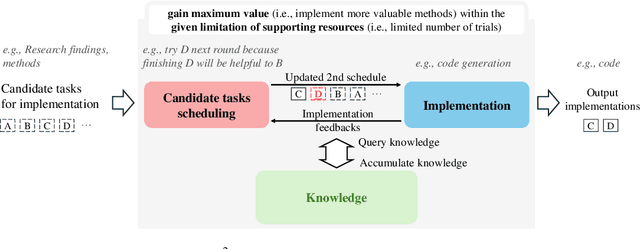

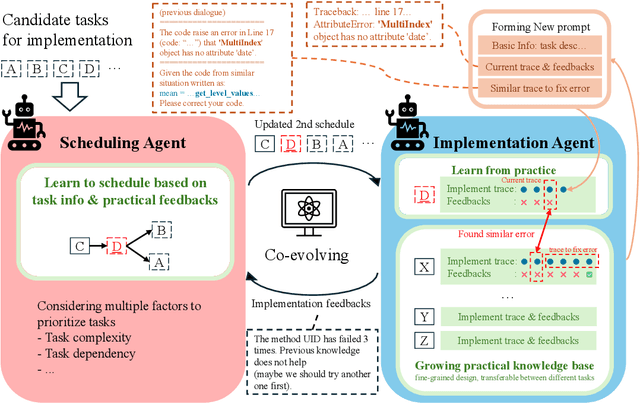

Abstract:Artificial Intelligence (AI) significantly influences many fields, largely thanks to the vast amounts of high-quality data for machine learning models. The emphasis is now on a data-centric AI strategy, prioritizing data development over model design progress. Automating this process is crucial. In this paper, we serve as the first work to introduce the automatic data-centric development (AD^2) task and outline its core challenges, which require domain-experts-like task scheduling and implementation capability, largely unexplored by previous work. By leveraging the strong complex problem-solving capabilities of large language models (LLMs), we propose an LLM-based autonomous agent, equipped with a strategy named Collaborative Knowledge-STudying-Enhanced Evolution by Retrieval (Co-STEER), to simultaneously address all the challenges. Specifically, our proposed Co-STEER agent enriches its domain knowledge through our proposed evolving strategy and develops both its scheduling and implementation skills by accumulating and retrieving domain-specific practical experience. With an improved schedule, the capability for implementation accelerates. Simultaneously, as implementation feedback becomes more thorough, the scheduling accuracy increases. These two capabilities evolve together through practical feedback, enabling a collaborative evolution process. Extensive experimental results demonstrate that our Co-STEER agent breaks new ground in AD^2 research, possesses strong evolvable schedule and implementation ability, and demonstrates the significant effectiveness of its components. Our Co-STEER paves the way for AD^2 advancements.
LayoutPrompter: Awaken the Design Ability of Large Language Models
Nov 11, 2023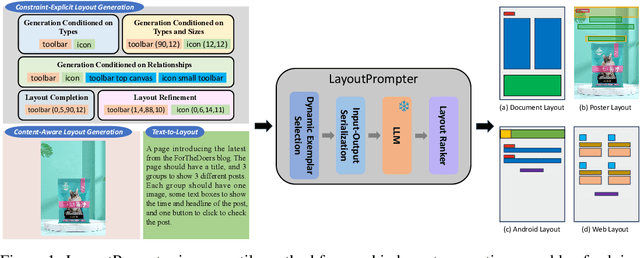

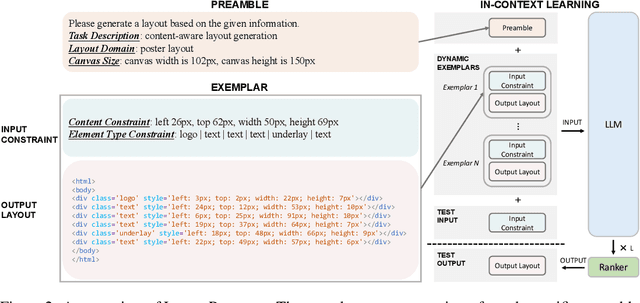

Abstract:Conditional graphic layout generation, which automatically maps user constraints to high-quality layouts, has attracted widespread attention today. Although recent works have achieved promising performance, the lack of versatility and data efficiency hinders their practical applications. In this work, we propose LayoutPrompter, which leverages large language models (LLMs) to address the above problems through in-context learning. LayoutPrompter is made up of three key components, namely input-output serialization, dynamic exemplar selection and layout ranking. Specifically, the input-output serialization component meticulously designs the input and output formats for each layout generation task. Dynamic exemplar selection is responsible for selecting the most helpful prompting exemplars for a given input. And a layout ranker is used to pick the highest quality layout from multiple outputs of LLMs. We conduct experiments on all existing layout generation tasks using four public datasets. Despite the simplicity of our approach, experimental results show that LayoutPrompter can compete with or even outperform state-of-the-art approaches on these tasks without any model training or fine-tuning. This demonstrates the effectiveness of this versatile and training-free approach. In addition, the ablation studies show that LayoutPrompter is significantly superior to the training-based baseline in a low-data regime, further indicating the data efficiency of LayoutPrompter. Our project is available at https://github.com/microsoft/LayoutGeneration/tree/main/LayoutPrompter.
A Parse-Then-Place Approach for Generating Graphic Layouts from Textual Descriptions
Aug 24, 2023



Abstract:Creating layouts is a fundamental step in graphic design. In this work, we propose to use text as the guidance to create graphic layouts, i.e., Text-to-Layout, aiming to lower the design barriers. Text-to-Layout is a challenging task, because it needs to consider the implicit, combined, and incomplete layout constraints from text, each of which has not been studied in previous work. To address this, we present a two-stage approach, named parse-then-place. The approach introduces an intermediate representation (IR) between text and layout to represent diverse layout constraints. With IR, Text-to-Layout is decomposed into a parse stage and a place stage. The parse stage takes a textual description as input and generates an IR, in which the implicit constraints from the text are transformed into explicit ones. The place stage generates layouts based on the IR. To model combined and incomplete constraints, we use a Transformer-based layout generation model and carefully design a way to represent constraints and layouts as sequences. Besides, we adopt the pretrain-then-finetune strategy to boost the performance of the layout generation model with large-scale unlabeled layouts. To evaluate our approach, we construct two Text-to-Layout datasets and conduct experiments on them. Quantitative results, qualitative analysis, and user studies demonstrate the effectiveness of our approach.
LayoutDiffusion: Improving Graphic Layout Generation by Discrete Diffusion Probabilistic Models
Mar 21, 2023



Abstract:Creating graphic layouts is a fundamental step in graphic designs. In this work, we present a novel generative model named LayoutDiffusion for automatic layout generation. As layout is typically represented as a sequence of discrete tokens, LayoutDiffusion models layout generation as a discrete denoising diffusion process. It learns to reverse a mild forward process, in which layouts become increasingly chaotic with the growth of forward steps and layouts in the neighboring steps do not differ too much. Designing such a mild forward process is however very challenging as layout has both categorical attributes and ordinal attributes. To tackle the challenge, we summarize three critical factors for achieving a mild forward process for the layout, i.e., legality, coordinate proximity and type disruption. Based on the factors, we propose a block-wise transition matrix coupled with a piece-wise linear noise schedule. Experiments on RICO and PubLayNet datasets show that LayoutDiffusion outperforms state-of-the-art approaches significantly. Moreover, it enables two conditional layout generation tasks in a plug-and-play manner without re-training and achieves better performance than existing methods.
UniLayout: Taming Unified Sequence-to-Sequence Transformers for Graphic Layout Generation
Aug 17, 2022


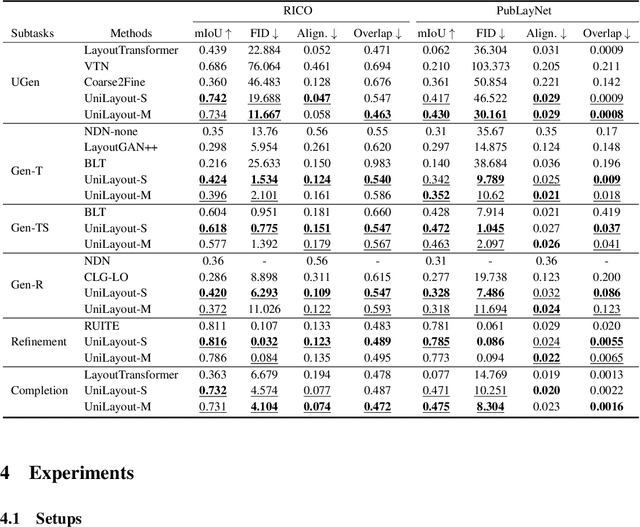
Abstract:To satisfy various user needs, different subtasks of graphic layout generation have been explored intensively in recent years. Existing studies usually propose task-specific methods with diverse input-output formats, dedicated model architectures, and different learning methods. However, those specialized approaches make the adaption to unseen subtasks difficult, hinder the knowledge sharing between different subtasks, and are contrary to the trend of devising general-purpose models. In this work, we propose UniLayout, which handles different subtasks for graphic layout generation in a unified manner. First, we uniformly represent diverse inputs and outputs of subtasks as the sequences of tokens. Then, based on the unified sequence format, we naturally leverage an identical encoder-decoder architecture with Transformers for different subtasks. Moreover, based on the above two kinds of unification, we further develop a single model that supports all subtasks concurrently. Experiments on two public datasets demonstrate that while simple, UniLayout significantly outperforms the previous task-specific methods.
Slim-DP: A Light Communication Data Parallelism for DNN
Sep 27, 2017
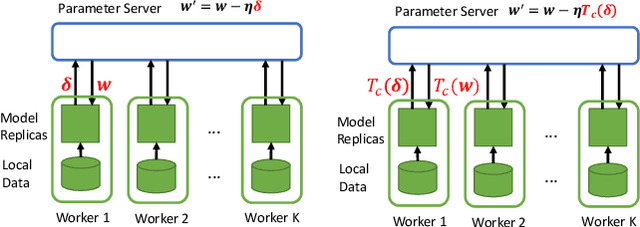


Abstract:Data parallelism has emerged as a necessary technique to accelerate the training of deep neural networks (DNN). In a typical data parallelism approach, the local workers push the latest updates of all the parameters to the parameter server and pull all merged parameters back periodically. However, with the increasing size of DNN models and the large number of workers in practice, this typical data parallelism cannot achieve satisfactory training acceleration, since it usually suffers from the heavy communication cost due to transferring huge amount of information between workers and the parameter server. In-depth understanding on DNN has revealed that it is usually highly redundant, that deleting a considerable proportion of the parameters will not significantly decline the model performance. This redundancy property exposes a great opportunity to reduce the communication cost by only transferring the information of those significant parameters during the parallel training. However, if we only transfer information of temporally significant parameters of the latest snapshot, we may miss the parameters that are insignificant now but have potential to become significant as the training process goes on. To this end, we design an Explore-Exploit framework to dynamically choose the subset to be communicated, which is comprised of the significant parameters in the latest snapshot together with a random explored set of other parameters. We propose to measure the significance of the parameter by the combination of its magnitude and gradient. Our experimental results demonstrate that our proposed Slim-DP can achieve better training acceleration than standard data parallelism and its communication-efficient version by saving communication time without loss of accuracy.
 Add to Chrome
Add to Chrome Add to Firefox
Add to Firefox Add to Edge
Add to Edge